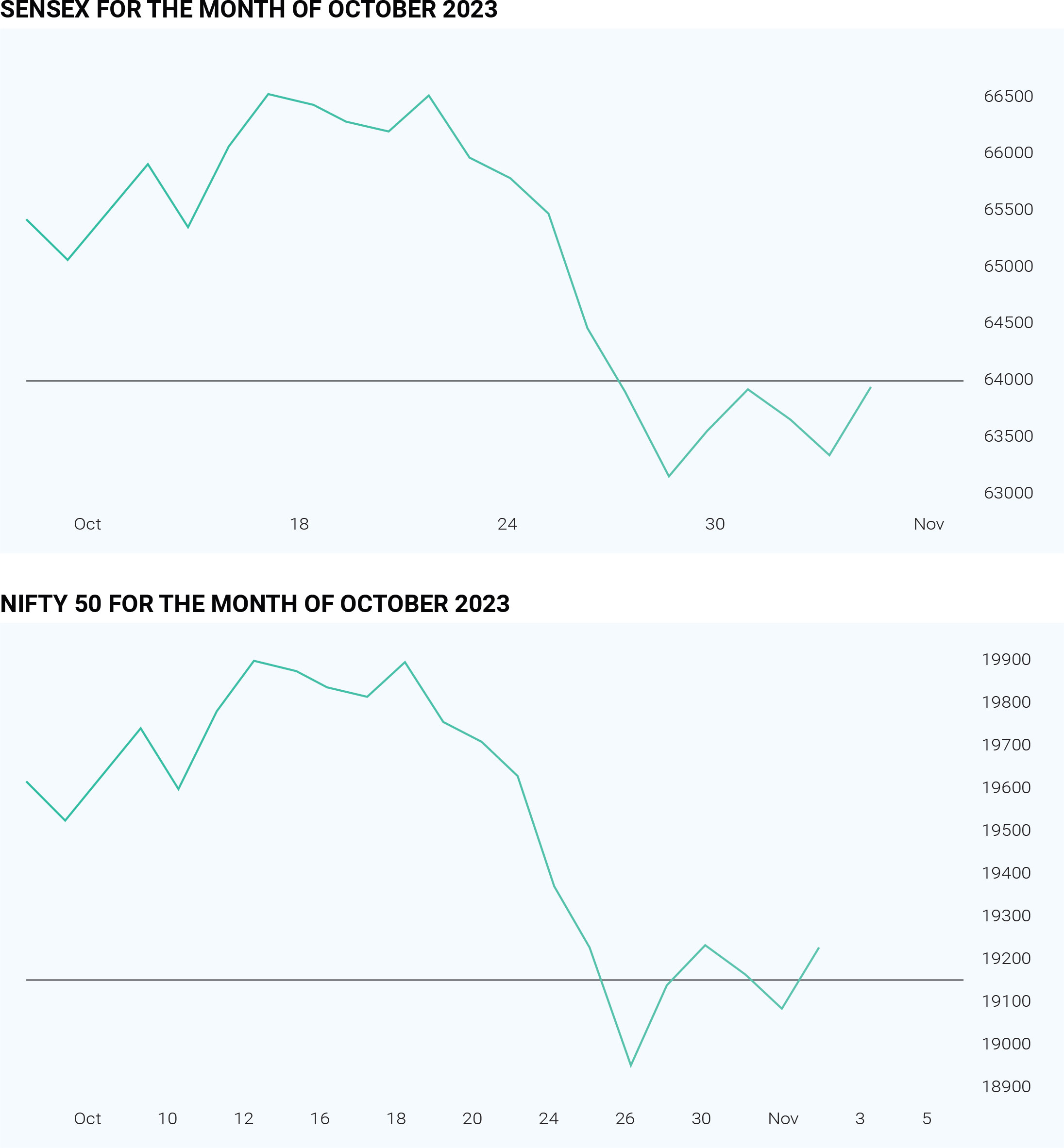October is the worst month for markets in the year 2023.
The months started with the pressure of a higher US fed
rate for a long period to bring down the inflation numbers
targeting 2%. Still, the Monetary Policy Committee of the
RBI maintained a status quo on repo rates and policy
stance. In the first 2 weeks, Sensex posted minor gains
whereas Nifty gained 0.8%. The sectors which gained the
most were realty, consumer durables and IT sector. The
military conflict in the Middle East weighed down the
markets across the globe. But sentiments were boosted
after the dovish statements of US Fed officials that the
US Fed may not raise interest rates further and also the
positive domestic macroeconomic data added to the
gains after India’s Industrial Output rose to a 14-month
high in Aug 2023 and India’s retail inflation eased to a
three-month low in Sep 2023. In the second and third
weeks markets felt the brunt of the escalating Middle
East conflict, dipping to the lower levels and erasing the
major gains. The domestic equity markets were in a bear
grip due to many factors like the meltdown of global
equity markets, higher US treasury yields, geo-political
tensions in the Middle East, ongoing Ukraine conflict and
the monthly expiry of futures and options. However,
some buying at lower levels in quality stocks attracted
few domestic buyers. The Sensex posted a loss of
around -2.5% declining from 65512.10 to 63874.93
points. The Nifty 50 loses around -2% from the level of
19622.40 to 19232.95 at the month's end. The Israel-
Hamas conflict seems to involve Iran and other
neighbouring countries as it is getting critical day by day.
This war has affected the crude oil prices which have
reached nearly $100 per barrel putting pressure on world
economies. With the rise in US bond yields above 5%
investors are pulling out from risky assets to safer bonds
and other assets. Due to the above reasons, foreign
institutional investors (FII) offloaded shares worth net Rs
1,761.86 crore, while domestic institutional investors
(DII) added shares worth net Rs 1,328.47 crore on
October 30, 2023, according to the provisional data
available on the NSE. For the month till October 30, 2023,
FIIs sold shares worth a net Rs 28,360.59 crore while DIIs
bought shares worth a net Rs 24,765.61 crore. DIIs are
picking up quality stocks at the lower levels of the
market.
The FIIs are net buyers in the Indian debt markets with
geo-political uncertainties looming and also the strong
macroeconomic conditions with a stable rupee,
investors are investing in safer options. The Indian bond
yields rose sharply in October 2023, since the US Yields
were also touching their highs. Bond yields rose on the
back of rising U.S. treasury yields which reached its peak
since the 2007 financial crisis. Elevated crude oil prices
amid the escalating conflict in the Middle East extended
the losses further. The local factors that support the rise
in bond yields are - RBI’s announcement to conduct an
open market sale of bonds through auction, the inclusion
of Indian bonds in the JP Morgan Debt Index and lastly
fall in domestic retail inflation. With the festive season,
consumer spending is high and the government is trying
to keep food inflation in control by various trade
restrictions on staples. Higher US treasury yields have
started hurting the Indian bond debt negatively now.
The rupee was rangebound due to higher crude oil prices,
higher US treasury yields and lastly bearish phase of the
domestic equity market. The Gold prices were falling as
the month started but as the Middle East conflict
intensified the prices soared being a safe haven for the
investors. The crude oil prices also were falling due to
slow macroeconomic numbers and high-interest rates
across the globe. Crude oil prices are now moving
according to the developments in the Israel- Hamas
conflict as it affects the oil production region. The Indian
markets maintained a high valuation despite
long-standing imbalances in the economy, including high
inflation, elevated bond yields, geopolitical tensions and
supply constraints.


